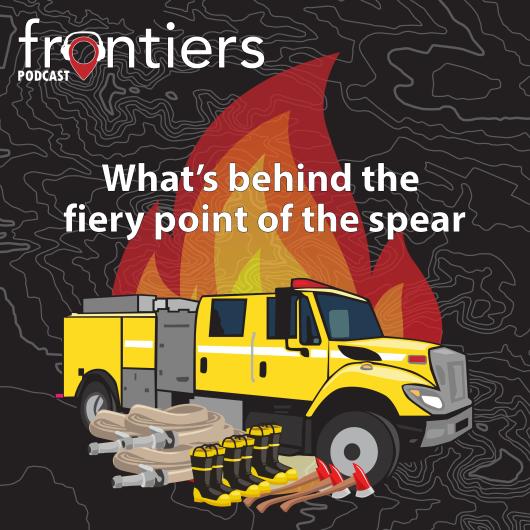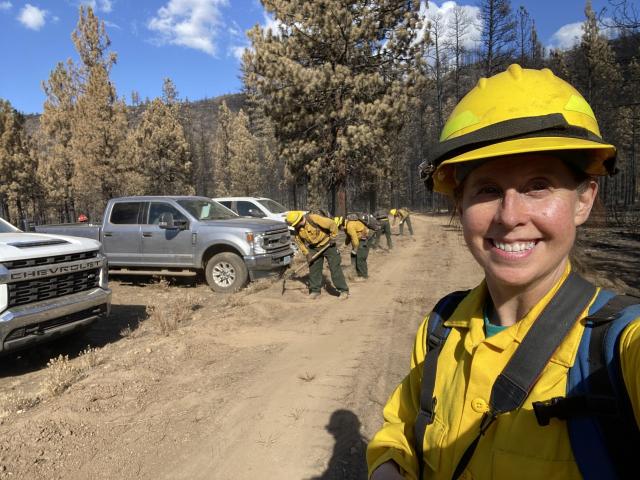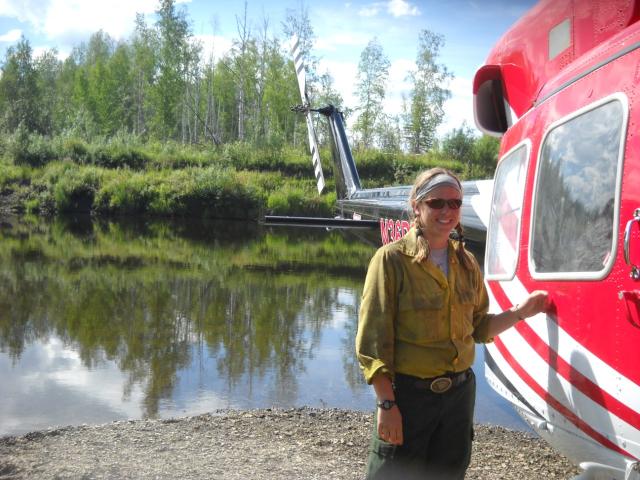You are viewing ARCHIVED content published online before January 20, 2025. Please note that this content is NOT UPDATED, and links may not work. Additionally, any previously issued diversity, equity, inclusion or gender-related guidance on this webpage should be considered rescinded. For current information, visit https://www.blm.gov/blog.
Podcast: What’s behind the fiery point of the spear

Transcript
[Jim Hart]: Welcome to the BLM Alaska Frontiers podcast, I'm Jim Hart. There are multiple ways for non firefighters to help fight fires in Alaska, and most don't require the use of a pulaski or a fire hose. The most visible part of the fire is the glowing, hot and smoky part where the firefighters do their craft. It's also the part most of us see on TV, so you are forgiven if you weren't aware that finance and supply people are within a few miles of the action. Today, we're going to talk with Chief of Fire Training Amy Skraba and public affairs specialist Beth Ipsen, both from the Alaska Fire Service, to see what's involved in supporting a fire. Amy Beth, thanks for joining us.
[Beth Ipsen]: My pleasure.
[Amy Skraba]: Thanks for having us.
[Jim Hart]: So I guess the first question is, what's it like supporting a fire? Amy, let's start with you.
[Amy Skraba]: Well, I think each fire assignment is definitely different and unique. It can be challenging. It can be fun at the same time. You know, every assignment is different, for sure.
[Jim Hart]: So Beth, you've worked quite a few fires and you've been pretty close to the action. What's it like?
[Beth Ipsen]: Well, I am not what you would call on the front on the fire line. I'm back in kind of more of a support position, getting information out to people. But still, I'm working long hours with a group of people every day that are all working towards a common purpose and that's keeping people safe from wildfires.

[Beth Ipsen]: And these people come from all different walks of life and background, but we all come together for that sole purpose of managing a stressful and often chaotic situation.
[Jim Hart]: So what kinds of backgrounds and occupations are we talking about when it comes to supporting fires?
[Beth Ipsen]: Do you want to go first, Amy?
[Amy Skraba]: No, go ahead, Beth.
[Beth Ipsen]: Ok. You know, a lot of times you have different types or different number of people working in support of a fire. It depends on, say, the impact that it has on a community, how large of a fire. But you could have logistics people that are helping get supplies out to the people on the fire line. You have finance people that are keeping track of costs and the hours that people are working on the fire and ensuring that people get paid for not only the equipment that are hired on a fire, but say, you know, the people working on the fire. We also have people providing food and even people keeping track of paperwork that's generated from this fire.
[Amy Skraba]: And I think too, there's we have something that's called the plans function and within plans, you know, they do a lot of getting the incident objectives ready to send out to all the firefighters on the ground, a lot of tracking of resources where each resource is going each day. You know, at times we need folks to drive supplies out to the fire line, pick people up from the airport.

[Amy Skraba]: You know, it really depends upon the fire and its location. But we definitely couldn't get the job done without the support of all the different functions in the background.
[Jim Hart]: So where would these people be located? Are they going to be really close to the fire or are they further back?
[Beth Ipsen]: Generally, it depends on where the fire is. We, you know, the Alaska Fire Service. We cover fire suppression services for the northern half of the state. So a lot of times we have people working on fires out in the middle of nowhere. You could be in a camp, 20 people camped out, not far from the fire line. Sometimes, you know, operating off of a gravel bar or you could have people. Nowadays we we've had increase in people working virtually on a fire. And a lot of those support systems say the finance section they can kind of help with, and you can also be located in a large camp. Large camps are typically more of what you see in the lower 48 here in Alaska. It's not as common just because of a lot of times the locations of the fires.
[Amy Skraba]: And I think another important piece, Beth mentioned these large camps, the large camps that you find, we call them incident command posts. They're like little mini towns that pop up a lot of times at those command post. You'll be working in a little yurt with your computer.
Typically, if you're in finance, the supply section sets up a big area for supplies versus in Alaska. Most of our assignments, you know, the only folks that are at that incident command post at times are really from our plans section ICs (Incident Commanders) and some of the some of the overhead and finance logistics ends up going to the field more often than not. So it really depends upon each fire itself where you would be working.
[Jim Hart]: We kind of touched on this a little bit earlier, but how critical is the support? I mean, let's unpack that a little bit.
[Amy Skraba]: Well, they're very critical. I mean, the mission, we kind of achieve everything like we could achieve putting the fire itself out if it was a small fire. However, we couldn't achieve getting different folks paid, taking care of homeowners that are in the area of the fire, you know, getting all the different supplies that are needed and refurbishing the supplies. You know, a lot of these support functions, they continue in their jobs long after the actual fire itself is out. You might not see the fire on the news anymore or hear about it, but there's still these support folks working in the background to make sure that we are ready for whatever the next fire assignment may be.
[Beth Ipsen]: And plus, they also ensure that people, the firefighters are getting fed and they're getting the equipment that they need to put out the fire. That's kind of important.
[Jim Hart]: Yeah, it is. And the other thing is, too, is the BLM doesn't work these fires by itself.
[Jim Hart]: It works with other agencies. What agencies have you worked with?
[Beth Ipsen]: Yes, I've worked alongside people from directly from communities, I've worked one year with a firefighter who was from the local fire departments, and he had most of his career was working with structure? So structure fires. So it was interesting. I mean, while we have the same common training and qualifications, he had a couple of different terms. He used the term fire ground for something. And the rest of us who have only experienced, you know, dealt with wildland fires. We kind of turned and looked at him and it's like, "fire ground"? Fire ground. He had to explain what it was, but basically it was generally what the fire area, the area of the fire where the fire was and the surrounding area. So it kind of came a joke, you know, we would we would slip in fire, ground every conversation, every chance we could. But I've also worked with federal and state counterparts. I know a park service ecologist who actually fills in roles in support, or in supply. So it's a great chance for people to kind of do more and gain more experience in their day job, but also do different things that they don't necessarily [do normally or that] are applicable to their day job as just something that's maybe a little fun for them.
[Amy Skraba]: Yeah, and I've also I've gotten to know a lot of people from some of the the remote villages in Alaska.
[Amy Skraba]: When we set up fire camps in those villages, sometimes we are able to hire people as drivers for vehicles or to operate a boat. So, you know, that's been a unique experience getting to know some of them and their way of life, as well as I've even had the opportunity to work with people from other countries. I have worked with folks from Canada, from New Zealand and Australia on fires, so that always somewhat makes for an interesting assignment, because while they fight fire, they do it differently. And so it's interesting to to learn from them and for them to learn from us as well.
[Jim Hart]: And that's a pretty good point because the firefighters in Alaska sometimes go down to Australia to help, right?
[Beth Ipsen]: If the season is bad enough, yes, in 2019, we did.
[Jim Hart]: So do either of you have a favorite story to share?
[Amy Skraba]: I don't know if I have a favorite story because I have lots of stories from from my time and fire was pretty early in my career as just, you know, I was on a Hotshot crew. I woke up one morning with a really bad poison oak all over my face, barely probably unrecognizable, I would say. I do know when I went and showed my supervisor, he gasped. But anyway, while we were waiting in line for the caterer, some of the folks that were supporting the fire, a lot of the the caterers had some interesting comments about my Halloween costume of poison oak.
[Amy Skraba]: It was all fun and good, and I was glad that they were able to make it humorous for me too, even though I had lots of itchiness going on in my face and my arms. One of those unique times where working with the folks supporting the fires made my day a little better.
[Beth Ipsen]: [chuckling] I'm so sorry, I'm over here just silently laughing. Oh, that's horrible.
[Amy Skraba]: I have a picture I can share, but I won't.
[Beth Ipsen]: Oh God, that's got to be horrible. And then that doesn't go away right away, too.
[Amy Skraba]: No. And it was the time of year and it was in Southern California, and it was the time of year when the leaves had fallen off the trees, for the most part. So, as we were clearing the brush in the ground, we didn't necessarily know we were touching poison oak.
[Jim Hart]: And that brings up the point we brought up earlier that you guys travel, and sometimes you guys are seeing some pretty remote areas that nobody gets to see, you know?
[Beth Ipsen]: And that's one thing is that, you know, we get to go to some of the most amazing places to work on fires. I don't know how many times I've been somewhere, and I've been up north of the Arctic Circle, working on a piece of land, an it's one of the most beautiful pieces of land that people rarely get to see. And then later on, I'm down in California and working in the Sierra Nevadas and just in another beautiful piece of land, but totally different.
[Beth Ipsen]: And every time I go down to the Lower 48 on a fire assignment, I'm somewhere where I'm like, "Man, I would love to come back here and actually enjoy it and not be working." And that's, you know, that's one of the great benefits about going out on fire assignments and working in Fire.
[Jim Hart]: So considering everything that you've seen, everything that you've been through, would you do it again?
[Beth Ipsen]: Oh heck yeah. I just wish I would have known about it a long time ago.
[Jim Hart]: How about you, Amy?
[Amy Skraba]: Oh, I would do it again, for sure. It's definitely been an interesting career, and you know, it is a unique career. You can start and one functional area you could start, as you know, on the ground firefighter, and you could eventually move into a different function and get the experience more than necessarily what you started out as. So, but yeah, I would do it again.
[Beth Ipsen]: Yeah, and I've worked with PIOs that have done other things, you can have multiple qualifications and do something different on each fire and, like Amy said earlier, no fire is same. It's always different. It's a really good variety.
[Jim Hart]: So it sounds like there's always something to keep you interested.
[Beth Ipsen]: It doesn't get boring, that's for sure.
[Jim Hart]: Would you recommend it to somebody else?
[Amy Skraba]: Oh, I would definitely recommend that if someone is interested that they they look into supporting fires. I think a good place to start is reach out to potentially your local BLM office or in Alaska, your Department of Forestry office or the Forest Service.
[Amy Skraba]: If there's offices there and try to get some direction from them about where you could start. Another great way to start is if you know anybody who does wildland fire, ask them more about it. Those folks there who've done the job can definitely point you in the right direction fairly quickly.
[Beth Ipsen]: And one thing as Alaskans. Wildfires are prevalent in Alaska. It's, you know, just about every summer somebody is impacted by wildfire, and this is a way for you to get involved and be directly part of the effort.
[Amy Skraba]: And I think one other important thing to add is if you are at all interested in supporting fires, don't wait until you see the smoke in the sky. Do it early because by the time you see that smoke, that fire burning, those folks that can help you get into the field are going to be too busy to help you? So definitely look into it sooner than later.
[Beth Ipsen]: Typically, the bulk of our training is done early, early in the year or even in the spring, so look into it, start in the winter, think about it in the winter.
[Jim Hart]: All right. Thanks, Beth. Thanks, Amy. That's it for this podcast. Be sure to go to the BLM Alaska Fire Service website under the AFS Jobs tab for more information about how to join the team and look at the range of jobs they have. For the state of Alaska, go to the Division of Forestry website at Forestry.Alaska.Gov/fire/ffresources.
If you're already a Department of the Interior employee, be sure to look into getting your red card. There's a lot of training involved, so the earlier you start, the better. The Frontiers podcast is a production of the BLM Alaska Office of Communications.
James Hart, Public Affairs Specialist
Related Stories
- Progress on Public Lands: BLM 2025 Trump Administration Accomplishments | January 20 - December 31, 2025
- BLM Fire Team brings Smokey Bear to Kingman’s Street of Lights
- Rural wildland firefighting partners grateful for BLM gift
- Using science to uncover mysteries of the Mesa archaeological site in Alaska
- BLM hosts fire investigation training course to strengthen wildland fire investigation capacity across Arizona and the West
Office
222 W 7th Avenue #13
Anchorage, AK 99513
United States
